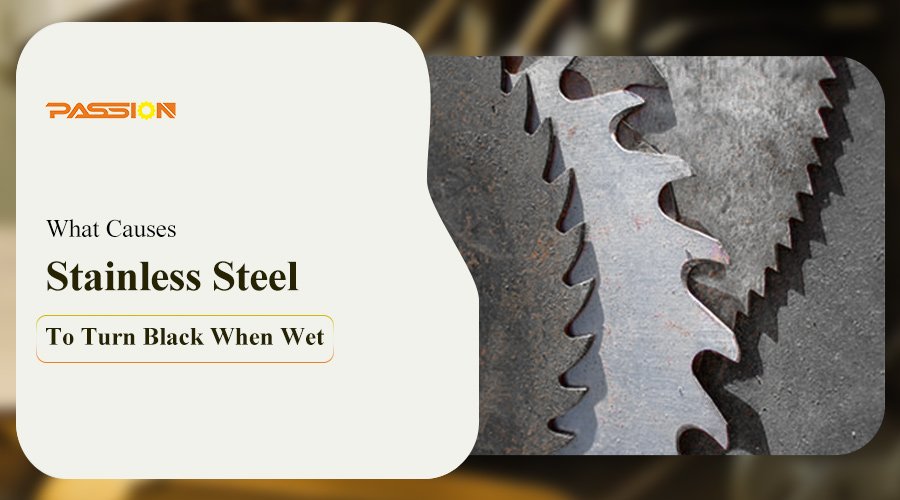Stainless steel is known for its resilience and resistance to rust, making it ideal for industrial applications. However, many of our users find that their stainless steel sometimes turns black when exposed to moisture. For those of you who rely on stainless steel’s strength, understanding why this happens and how to prevent it is essential to maintain the integrity and durability of your products.
Stainless steel can turn black when wet due to chemical and electrochemical corrosion. This process occurs as the metal reacts with oxygen and water or interacts with certain chemicals like acids and sulfur compounds. Moist environments accelerate these reactions, resulting in a dark residue or tarnishing on the surface of the steel.
Let’s look at why this discoloration happens, how to restore the original finish, and how to prevent your stainless steel from turning black.
What Causes Stainless Steel To Turn Black When Wet?
Stainless steel turning black when wet is mainly due to two types of corrosion: chemical corrosion and electrochemical corrosion.
Chemical Corrosion: This happens when stainless steel reacts directly with oxygen in the presence of moisture and starts an oxidation-reduction process. In this process, the metal surface loses its shine and gets a black layer. If there are impurities on the metal surface, this process gets worse with high humidity and exposure to oxygen.
Electrochemical Corrosion: Stainless steel, especially when it’s submerged in or exposed to electrolytic solutions, can have electrochemical reactions. These reactions usually happen when stainless steel touches an electrolyte, like saltwater, and creates a mild electrical current on the metal surface that leads to discoloration.
Presence of Sulfur Compounds and Acids: Certain chemicals also cause blackening, especially sulfur compounds and acidic environments. Sulfur can make the tarnish darker, while acids can create corrosive reactions on stainless steel surfaces, especially if the protective oxide layer has worn down.
How Do I Fix My Stainless Steel When It Turns Black?
Restoring stainless steel to its original appearance is possible with proper cleaning methods that won’t damage the metal. Here’s how to tackle blackened stainless steel effectively:
Use Mild Detergents and Cleaners: Start with mild dish soap mixed with warm water. Apply the solution to the surface using a non-abrasive cloth or sponge to lift away any surface-level dirt and black residue. Avoid harsh cleaners, which can make the discoloration worse.
Specialized Stainless Steel Cleaners: If mild soap doesn’t do the trick, consider using a specialized stainless steel cleaner that’s designed to target stains and oxidation without damaging the material. These products often contain compounds that restore the metal’s luster.
Non-Abrasive Scrubbing Tools: Non-abrasive sponges or microfiber cloths are ideal for scrubbing. Avoid steel wool or harsh abrasives, which can scratch the surface and make the metal more prone to future corrosion.
Apply Baking Soda Paste: Make a paste with baking soda and water to remove stubborn stains. Baking soda is non-abrasive and will clean gently without hurting the steel. Put the paste on, let it sit for 10–15 minutes, and scrub lightly with a soft brush.
Doing regular maintenance will help you get your blackened stainless steel back to looking like new, so it will last a long time.
How Do You Remove Black Oxidation From Stainless Steel?
If the stainless steel has developed a deeper oxidation layer, use a more targeted approach to remove it:
Baking Soda Solution: Mix 1 tablespoon of baking soda with 2 cups of water. Baking soda is gentle but effective at removing oxidation. Using a clean, soft cloth or toothbrush, put the mixture on the stained areas, rubbing in circles, then rinse with water and dry.
White Vinegar Solution: For tougher stains, you can use white vinegar mixed with equal parts water to break down oxidation. Put this on with a cloth and let it sit for a little bit before you scrub it. Be careful with acidic cleaners, though, because if you leave them on too long, they can damage stainless steel.
Rinse and Dry Thoroughly: After you use these solutions, rinse really well so there isn’t any residue left to attract moisture, which could make oxidation happen faster. Always dry the metal completely so you don’t get water spots and tarnishing.
These techniques will help you get rid of black oxidation on stainless steel, so it looks clean and shiny.
What Chemicals Can Cause Stainless Steel To Turn Black?
Some specific chemicals may cause blackening on stainless steel, including:
Sulfur Compounds: Sulfur is often found in industrial and kitchen environments and can react with stainless steel, making it turn black. Sometimes, foods high in sulfur, like onions and garlic, can cause this reaction on kitchen tools.
Acids: Hydrochloric acid, sulfuric acid, and other acids that eat away at things can make stainless steel turn black or corrode. In industrial settings, it’s important to watch out for exposure to acids, especially if they sit on stainless steel surfaces for a long time.
Chlorine: Chlorine is in a lot of cleaning products and can eat away at stainless steel over time, making it turn black. Always rinse stainless steel after you use cleaners with chlorine in them so it doesn’t turn black over time.
Knowing what chemicals are around your stainless steel stuff can help you avoid things turning black that you don’t want to turn black and make your industrial equipment and tools last longer.
Is Black Residue On Stainless Steel Harmful?
In most cases, black residue on stainless steel is harmless, but it can look bad and might make a difference for food or product quality in some industries.
Looks: The black residue doesn’t usually hurt the stainless steel’s structure. But if you’re talking about stuff like cutlery or food-grade equipment, it can make it look bad and like it’s not good quality.
Quality: In industries like food processing, medical manufacturing, or chemicals, black stuff on stainless steel can make people worry about whether it’s contaminated. You have to keep it clean and take care of it in these cases to make sure the product is safe.
Extra Protection: If you keep getting black stuff on your stainless steel even though you’re cleaning it, you might want to think about using professional-grade stainless steel treatments to give it an extra layer of protection.
Usually, this black stuff is just on the surface, but in certain industries, you might have to do more to make sure your product is top-notch.
Best Practices To Prevent Stainless Steel From Turning Black
Preventive care is the best way to keep stainless steel from getting discolored or turning black. Here are the top things you can do to prevent it:
Keep Stainless Steel Dry: Moisture is a big deal when it comes to corrosion. After you clean it or get it wet, make sure you dry it really well with a clean, soft cloth.
Put on Protective Coatings: There are special coatings you can put on stainless steel that are made for industrial use. These coatings make a barrier between the metal and the stuff that makes it turn colors.
Don’t Use Harsh Chemicals: Don’t use cleaners with chlorine or acid in them on stainless steel, especially if you don’t rinse it off. If you have to use chemicals, make sure you wash them off right away and dry it.
Do Regular Maintenance: You should polish stainless steel with special products that are gentle and won’t scratch it. Doing this regularly will keep dirt, grime, and other stuff from building up and reacting with the metal.
Control the Environment: If you can, control the stuff around the stainless steel so it doesn’t get wet or come into contact with things that make it turn colors. This is especially important in industrial settings where you have big machines.
By following these steps, you can maintain stainless steel’s quality and appearance, ensuring a longer lifespan and better performance for your industrial tools.
Regular maintenance and preventive care can keep stainless steel from turning black and prolong its use. By understanding the causes of blackening, such as chemical reactions and exposure to moisture, and knowing how to clean it, you can keep your stainless steel in good shape. Keep your tools clean, dry, and treated with protective measures to make sure they stay in good condition.









